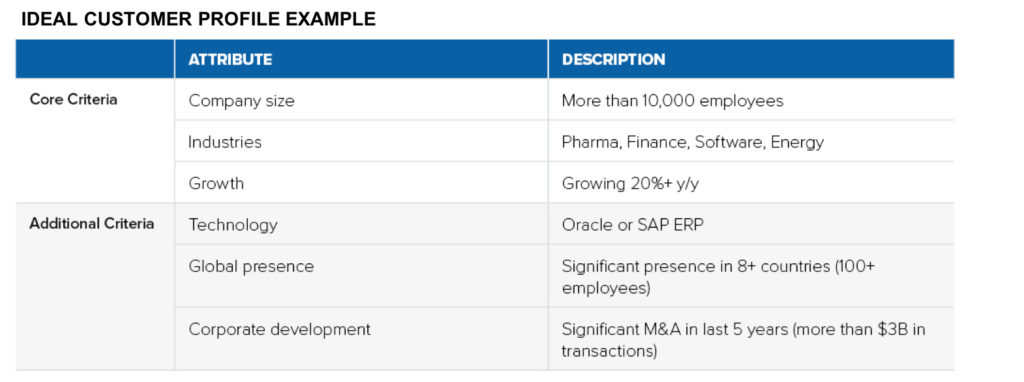5 Benefits of Creating an Ideal Customer Profile
The key objective of every B2B company is revenue growth. With this in mind, one would think organizations would capitalize on any available advantage to increase the percentage of deals that close. Creating an Ideal Customer Profile (ICP) is just such an advantage, and it provides a number of other benefits.
TOPO’s research into ICP development has found that it is often misunderstood, not properly defined, or even limited in its use. By contrast, in high-growth companies, the ICP is integral to B2B marketing and sales strategy and their execution.
Additionally, an ICP is a critical foundational element of an organization’s account based strategy for companies that have adopted that approach. Without an ICP, organizations struggle to align efforts to create a shared list of target accounts. We’ll be hosting a webinar on ICP Development on July 9th – register here.

1. Identify Best Customers
There is a sense of a company’s best customers in the go-to-market team. While this may come from anecdotal evidence or a limited data review, the ICP process uses quantitative and qualitative data to determine the similarities between the ideal customers.
Creating an Ideal Customer Profile begins by examining the characteristics of prospects and customers to determine a set of criteria that defines the accounts that are the best fit and provide the highest value for the company. Defining which accounts are a good fit begins by looking at all prospects, whether closed-won or closed-lost, and grouping them (e.g., by size or industry) to determine which groups have the highest win rates. This is one indicator, and often the most accessible. Renewal rate, account expansion, net promoter score (NPS), and customer satisfaction are additional indicators of fit.
Once fit is determined, it’s important to look at those accounts that spend the most. These customers provide high value to the business, as measured by metrics like ACV (annual contract value) or ARR (annual recurring revenue). But there are other ways companies can provide value. What about the accounts that always renew on time or the ones that are self-sufficient and never make support calls? What about accounts that are more likely to become company advocates? If these data points are tracked in the CRM or other internal systems, then they can be used to identify ideal customers.
2. Create Alignment Across Organization
A key benefit of an Ideal Customer Profile is creating alignment across the organization. It is a strategic way for all parts of a B2B company—particularly marketing, sales, sales development, and customer success—to align on the most important customers. It’s also how they come together to create an aligned, cohesive plan on how to prioritize go-to-market resources.
The ICP process brings organizational leaders together to describe the characteristics of the company’s best accounts. Rather than solely rely on the customer and prospect data gathered from the CRM, high-growth companies combine that with qualitative results from cross-functional teams. This also identifies accounts that are of ongoing strategic importance. For example, this process might surface the desire to land a well-known enterprise brand so the company can add the logo to its marketing materials.
3. Guide Creation of Target Account List
Unlike the term “target market,” which is often used to describe the companies that might buy a product or service, the ICP is used to identify the most valuable customers and prospects that are also most likely to buy. The ICP should not be confused with the total addressable market or total available market, which are estimates of the universe of potential target customers. The goal of the ICP is to identify the types of accounts that will receive a significant and disproportionate share of go-to-market investment as part of the target account list.
The output of the ICP is a list of customer and prospect attributes that can be applied to a list of accounts. The restrictive nature of the attributes—based on the company’s ideal customers—reduces the account list to one that is manageable with a likely higher win rate. Without an ICP, organizations often struggle to maintain focus on a list, because there is always “one more account” that is worth adding.
4. Determine How to Allocate Resources
ICP development is a first step in the process of resource allocation. After the creation of the target account list, an organization can determine the additional investment of time and resources on these accounts. The list guides resource allocation to support the go-to-market strategy. The ICP serves as the foundation for sales, sales development, marketing, and customer success teams, enabling them to appropriately fund the right programs directed at the right accounts.
5. Increase Win Rate
TOPO research data shows just how critical an effective ICP is. Organizations that have adopted account based strategies and developed a strong ICP average a 68% higher account win rate. And 81% of top-performing organizations are confident that their ICP represents their ideal accounts.
Also, organizations that combined qualitative input from stakeholders with prospect and customer data were 61% more likely to be confident that their ICP represents the attributes of the best accounts for the organization.
An Ideal Customer Profile helps all organizations create cross-functional alignment and dedicate additional resources to the right customers and prospects. With the additional benefits of ICP creation, every organization should create its own ICP to guide its go-to-market strategy.


